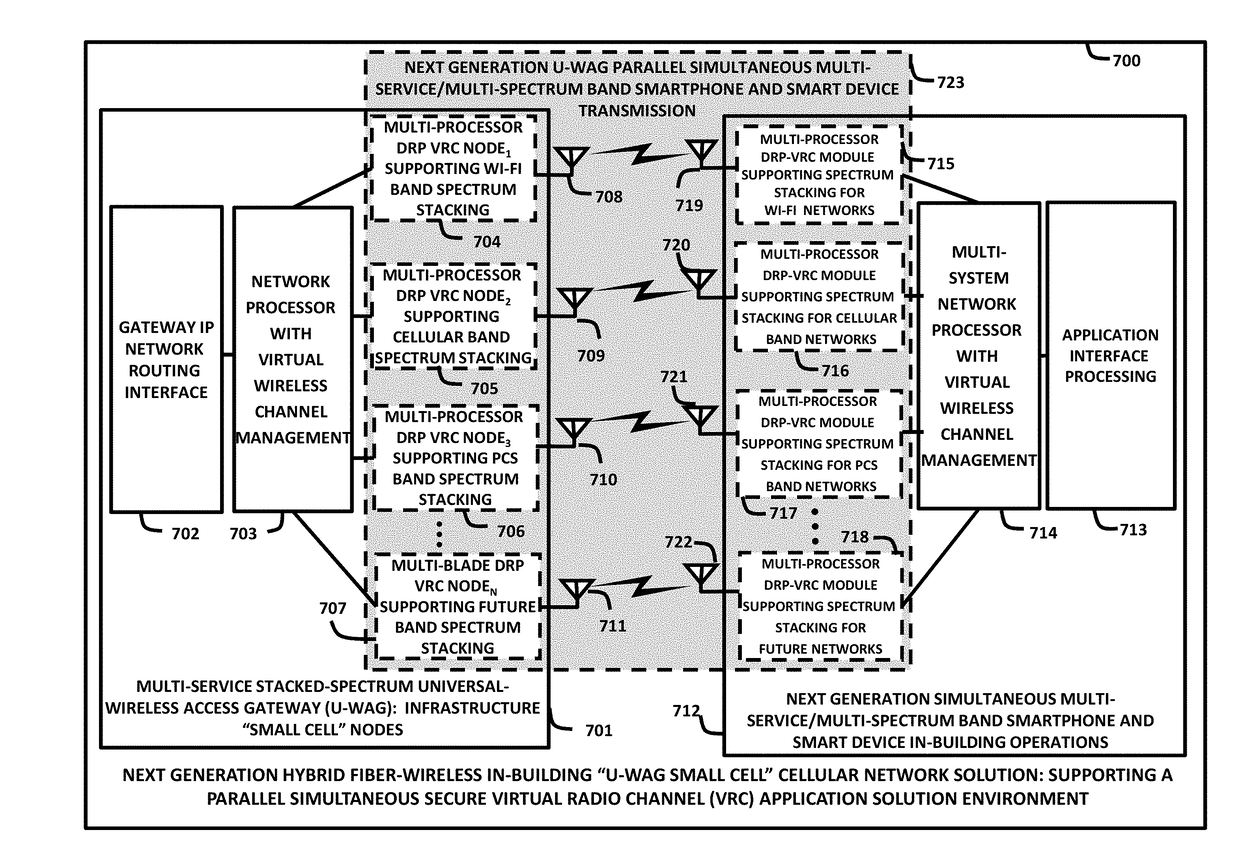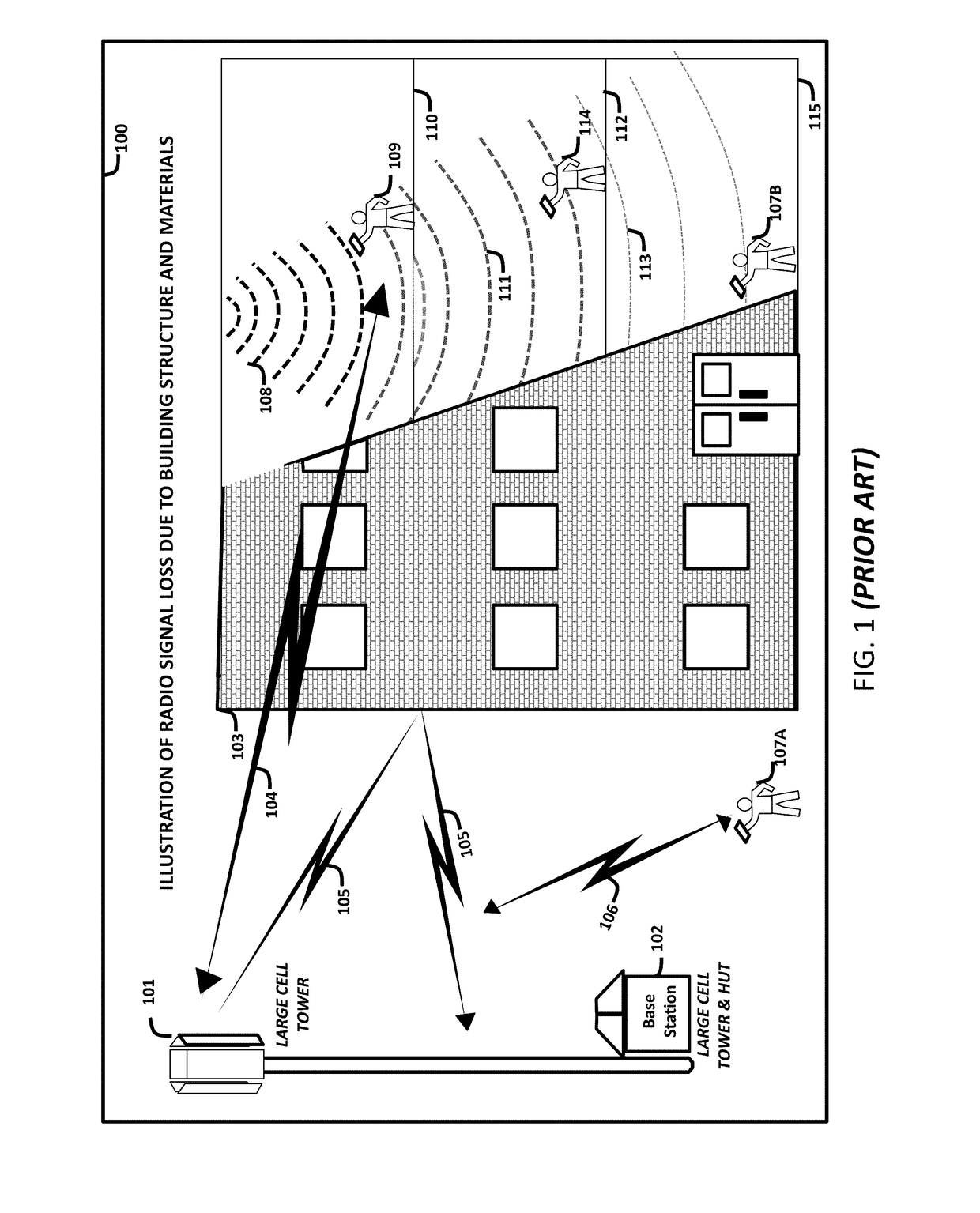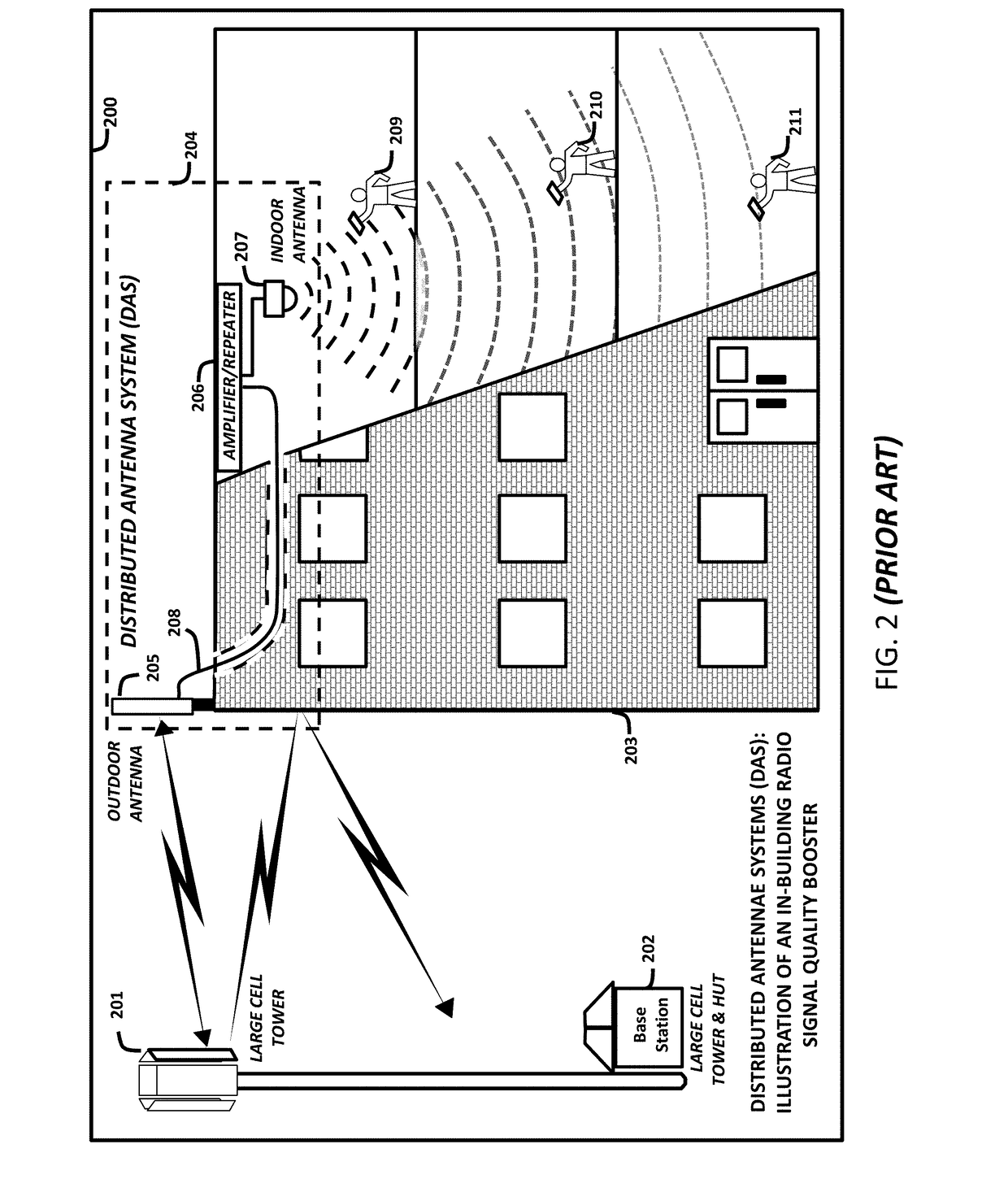However, these bands are frequently configured into separated frequency channels, mostly non-contiguously, and utilize different common air interfaces and
radio channel protocols, which makes it difficult to re-allocate these bands for new
wireless communications services and applications.
Although, this approach has achieved some success, it has two important drawbacks: it eliminates the ability of the channels to operate independently as before, and it requires the adherence to a new standard radio channel format.
Moreover, this approach cannot be used in situations where the channels are separated (not adjacent) or use different common air interfaces and radio channel protocols.
Given the growing demand for more in-building wireless communications services and applications, from the building owner's perspective, the most challenging issue facing the wireless communications industry is improving the
quality of service for wireless communications within office buildings.
However, in contrast to the building owner's perspective, the most challenging issue from the building tenant's perspective restricting the radio channel
transmission throughput within buildings is the quality of the
radio signal transmission within the building.
However, due to the building structure 103 as well as the type of materials used within the building, the
radio signal power level 111, 113 within the core of the building 103, can be very poor, which can significantly reduce the end-point device 107B, 114 transmission throughputs.
Although, these
radio transmission quality issues, which results from radio
signal loss due to building structures and materials are well known within the cellular industry, the cellular industry continues to struggle to find an optimum solution for in-building services quality issues.
This situation of
signal degradation or loss has caused building owners to demand that the cellular industry address the issue of cellular phone
service quality within their buildings.
These requests from cellular end-users are due to the fact that thousands of buildings suffer from poor or weak cellular phone reception and
signal coverage within the core structure of the building, resulting in poor cellular phone
service quality and
transmission throughput within the core structure of many buildings.
These radio signal fluctuations are due to the variability of the additional
layers of building materials that could also block or inhibit cellphone radio signal transmission within the building, if the DAS design is not optimally engineered for the building.
This is a common problem, if the DAS configuration 204 has not been custom designed for the specific building structure, building
layout, and materials.
An additional
engineering challenge for DAS is the management of radio signals near the windows, if a building 203 has a large number of windows; which means that the cellphone signal may not be completely blocked by building materials unless the windows have radio reflective material covering the windows.
If the windows have radio reflective material covering the windows, then, the end-user's cellphone just experiences a reduction of
usable transmission signal near the window.
Although, some DAS configuration may have unique
engineering challenges near windows, they can also have special
engineering design challenges in the “core” of the building, away from windows, such as,
elevator shafts, where the radio
signal quality may also be non-uniform; if the DAS configuration is not properly engineered for the internal building 203 structure and materials.
Another drawback of typical conventional DAS configurations is that they are static, and as such, they are not easily changed as the environment within the building changes, without significant cost.
They also do not provide the flexibility to dynamically learn and adapt to meet the changing tenant office space needs, which often involves internal building modifications and reconfigurations to meet new building
layout requirements, such as, office space rearrangements.
For instance, when a company's size or spacing needs change, the configuration of the walls may also need to be rearranged, which affects the radio signal propagation environment.
Unless the DAS is also manually reconfigured in accordance with the new office space rearrangement, this new rearrangement of the office space can adversely affect the radio
signal level detected by the end-point devices within the building, because the DAS has not been re-engineered to meet the new building configuration requirements.
The inability of the typical conventional DAS configuration to dynamically reconfigure itself through the use of
machine-learning techniques to accommodate internal building modifications and external RF frequency modifications increases the infrastructure, installation, and maintenance cost of DAS configurations.
Thus, installation and deployment of a DAS configurations within an owner's building can be cost-prohibitive for the building owner, because the building owner cannot recover these costs.
However, this radio signal rebroadcasting process may not necessarily improve the
radio transmission throughput capacity for the many cellular devices operating within the building. FIG. 2 is only an example of one typical type of DAS 204 configuration that has been used to address the inbuilding radio signal coverage quality of services issue.
Because distributed antenna systems operate within RF
licensed spectrum bands owned by wireless carriers, an enterprise building owner cannot undertake a DAS deployment within their buildings without involving at least one of the national cellular carriers.
This has been a major point of conflict between building owners and national carriers within the cellular industry.
However, additional quality of services issues can remain within the building, such as, service disruption during “
handover” and transmission throughput performance issues within the building during high usage periods when many users are occupying the building.
The quality of services issue related to service disruption during “
handover” is due to the design limitation of existing cellular smartphone, which can only support a single independent radio transmission connection to a single
base station system at a given point in time within the physical
radio frequency domain.
Thus, an indoor DAS configuration experiences the same problems during a “
handover” process that an end-point device user experiences, when the user is outdoors travelling from one cellular coverage area to another cellular coverage area, which is the transferring of a calling session in progress being transferred from one cellular base
station to another cellular base
station.
This radio transmission “handover” process is where the service disruption can occur.
Although this arrangement is straightforward, it limits the ability to aggregate more bandwidth for a given end-point device, as well as restricting the distribution of the user's information content over multiple radio resources or radio channels, if they are available to the end-point device.
In addition, this switching operation also interrupts the communication session, while the “handovers” (channel switches) are being negotiated.
Further, even with physical
radio frequency channel aggregation, disparate wireless networks and devices cannot utilize multiple physical radio frequency channels simultaneously to effectively increase transmission throughput capacity and enhance security for the wireless end-point devices.
 Login to View More
Login to View More  Login to View More
Login to View More 


